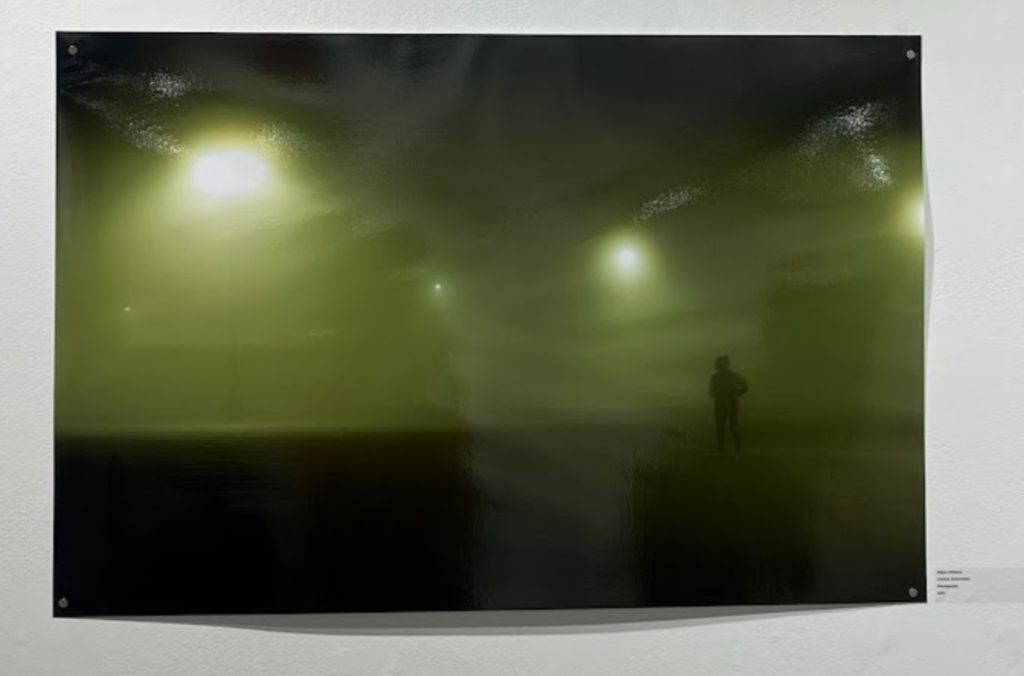Written By: Torri Byrd

Adjani “AJ” Williams is a 21-year-old senior at Valdosta State University, originally from College Park, GA. Williams works in multimedia and chose to display a variety of different styles of art in this exhibition. His works are divided between photography, oil painting, and encaustic, but all reflect the same overall motive. When I asked Williams to describe his work in one word, he chose “evocative”, and explained that all of the things he displays are reflective of some kind of ego death. Ego death is in reference to the rebirth of a person from self reflection. Williams summed it up his ego death as having “a renewed focus on painting what I feel- painting ideas or concepts that I cannot explain with words.”
This transition to conceptual art happened more recently in Williams’ college career as an attempt to be more relatable with his art’s meaning, allowing for more open-ended interpretations of his work. He creates works that cause varied reactions from the audience, instead of spelling it out for them. He created a sense of wonder for the viewers so that they may each interact with them in their own way. Williams gave me an example of this by explaining his use of texture in his column of paintings on the far right.

Self Portrait is an Oil painting by Williams where he utilizes the technique of impasto to represent his hair. The other two, the Turmoil paintings, use encaustic painting to create compositions that quite literally jump off of the page at the viewer grasping for more. All three of these incorporate a warm and somewhat dark color scheme that reflects the emotions Williams felt during the creation of these works. The texture along with the attention-grabbing colors cause the viewer to come forward and view the work from all angles both figuratively and literally.
Though, the use of color in William’s work is more important than the texture. Seen throughout the work displayed is a feeling created by color. In his minimalist color photography series, Remnants; Liminal, this is especially prevalent. Williams explains his use of photography as a way to capture the exactly perfect, fleeting moment. The works are often mysterious and dull in color with a desolate aura. He explains the vacant moments are some of the most beautiful and emotional for him. Williams says photography has never been his preferred choice of medium but has become important to him as a way to capture an exact expression.

On the far right, Williams displays the most contrasting photo of the series as a poster nearly three times as large as the other. Liminal: Somewhere was the first of the series that was displayed, and utilized color in a more apparent way than the others. The green foggy essence of the work creates a gateway for the solace experienced in the photographs to the right of it.

This collection of photographs is in identical frames and is arranged in a salon-style hang to create a sense of familiarity. All are pictures of a street view, and all have this essence of wander to them. One is a stoplight, while the others are walls and strange signs. These frames with mats were selected by Williams to emulate a contrasting feeling in comparison to the large poster print beside it. He wanted to propel the feeling of home and humility by the way he arranged these photos, photos that may feel forlorn or empty. The very minimal color in these is reflective of that fleeting moment Williams continuously discussed with me, though this lack of color very obviously is not true of all his paintings.

Not only were the three prior paintings I talked about true of William’s attention to color, but his painting Effigy of Isolation was even more important. The monochromatic blue piece is a pretty obvious example of the emotions that may be created by the viewer’s interpretation without screaming it at them. The blue body of Williams’ self is enveloped by the woods around him and has sprouts for arms. This is a clear indicator of a complex and troubling mood. Williams is able to translate his own personal and emotional experiences in a way that does not overtake the work itself. He has successfully found his balance and will continue to grow and change along with his work.
At the beginning of Williams’ time at VSU, he felt as though some of his work was just made to fulfill an assignment grade rather than to make something that represented him as an artist. These works are the exact opposite of that struggle. Williams identifies strongly with each of these and has recently developed a strong sense of self in his art. His exploration and grasp of new materials and subject matter have only just begun. There are so many directions Williams can go post-graduation, and I cannot wait to see where the road may take him.